One-Handed Setups: Essential Guide to Gaming & Typing Solutions
Updated On: November 12, 2025 by Aaron Connolly
Understanding One-Handed Setups
One-handed setups let gamers with physical limitations or temporary injuries keep playing at a high level. They mix adaptive hardware, custom controls, and ergonomic tweaks to build gaming systems that actually work.
Key Purposes and Benefits
One-handed setups fill a bunch of important roles in competitive gaming. They open the door for players with disabilities, folks recovering from injuries, or anyone with hand mobility issues.
Main benefits:
- Keep your competitive edge even when you’re healing up
- Welcome players with limb differences into the game
- Cut down on strain for your good hand by using proper ergonomics
These setups aren’t just a stopgap. Some pro esports athletes have actually won tournaments in Counter-Strike and League of Legends with one-handed gear.
Mouse-and-keyboard games, especially, benefit from these setups. A lot of pros say they still hit 80-90% of their usual performance after switching over.
Quick tip: Before dropping cash on hardware, try software remapping. Tools like AutoHotkey let you shuffle keys around for free.
Who Needs a One-Handed Setup?
Lots of gaming communities use one-handed setups. Knowing who uses them helps you figure out if you need one.
Temporary users are usually folks healing from injuries or surgeries. If you break a wrist or deal with carpal tunnel, you might need a different setup for a couple months.
Permanent users include gamers born with limb differences, amputees, or anyone with nerve issues in their hand. This group is growing, and some have even earned a name in the semi-pro scene.
Prevention-minded users sometimes switch to one-handed setups to avoid long-term injuries. You’ll see some streamers alternate between both styles during marathon sessions.
Esports organizers are starting to notice. Big tournaments now offer assistive tech support, and gear makers are releasing more one-handed devices.
Overview of Core Equipment
Modern one-handed gaming setups depend on three main types of gear: adaptive keyboards, programmable mice, and special controllers.
Adaptive keyboards put all the important keys within thumb and finger reach. Some popular choices:
| Device | Price Range | Key Features |
|---|---|---|
| Razer Tartarus Pro | £130-150 | 32 programmable keys, analogue inputs |
| Logitech G13 | £80-100 | LCD display, 25 keys plus thumbstick |
| Azeron Cyborg | £150-200 | Ergonomic grip, 26 inputs |
Programmable mice let you map tons of functions to buttons or gestures. Good sensors mean you barely have to move your hand.
Special controllers include one-handed console adapters and custom rigs. Microsoft’s Xbox Adaptive Controller, for example, connects to all sorts of switches and buttons.
Heads up: Steer clear of cheap knock-offs. They often don’t have good drivers or community support. Stick with trusted brands that update their software.
On the software side, key remapping programs, macros, and voice controls round out a one-handed gaming setup.
One-Handed Gaming Essentials
One-handed gaming setups blend special hardware, clever software, and a bit of workspace planning to keep things comfortable. The trick is finding the right mix of assistive tech and personal tweaks for your situation.
Types of One-Handed Gaming Setups
Gaming keyboards built for one hand are the most straightforward for PC gaming. Models like the RedThunder One-Hand Keyboard keep all the crucial keys within easy reach.
You’ll usually get:
- WASD keys for movement
- Number keys for quick actions
- Function keys for shortcuts
- Some programmable macro buttons
Adaptive controllers are another solid pick. The Xbox Adaptive Controller works with custom switches you can place wherever you want. It’s especially handy for console gaming.
Standalone controllers like the Azeron use finger-operated keys and a thumbstick. They feel different from regular gamepads but deliver great precision once you get used to them.
3D-printed options let you go wild with customization. Tons of designs are online, and you can have one printed to fit your hand exactly.
Role of Assistive Technology in Gaming
New assistive tech can turn tricky gaming setups into something manageable. Software remapping tools let you assign any game function to the buttons you can reach.
The Co-pilot feature on Xbox and PlayStation lets two controllers act as one. You could have a friend handle movement while you take care of aiming, or use foot pedals for some controls.
Switch-based systems connect lots of different input devices to one hub. You might use a chin joystick, big button switches, or pressure pads, depending on what feels best.
Voice control software like Dragon NaturallySpeaking can help you with menus and chatting. That means you won’t have to rely on physical buttons for everything.
A lot of games now offer built-in accessibility settings. These might include remapping, toggle options, or simpler control schemes—perfect for one-handed play.
Creating a Personalised Gaming Station
Mounting and positioning are crucial. Heavy-duty velcro keeps switches and controllers in place, even during intense play.
Set up your desk so that your main controls are always within easy reach. Adjustable monitor arms and keyboard trays help you find the right angle and hand position.
Cable management is a big deal when you have lots of devices. Use clips and organizers to keep wires out of your way.
Backup gear is a lifesaver. Keep spare switches, extra cables, and maybe another controller handy. You don’t want tech issues to end your session.
Set up game-specific profiles. Racing games might use foot pedals, while shooters could benefit from head tracking. Save these setups so you can switch fast.
Choosing a One-Handed Keyboard
Finding the best one-handed keyboard means knowing what types are out there and matching them to your style. Think about which keyboard category fits your games, what features matter (like switch type or programmability), and ergonomic design that keeps your hand happy.
Different Categories of One-Handed Keyboards
You’ll find four main kinds of one-handed gaming keyboards.
Gaming keypads are the top pick for competitive players. They usually have 20-35 keys in easy reach for your left hand. The Razer Tartarus V2 is a classic, with 32 keys and a thumbpad for movement.
Full-size one-handed keyboards keep all the QWERTY keys but rearrange them for one hand. These are great if you want to chat in games without swapping devices.
Miniature keyboards like the FrogPad use only 20 keys, but you press combos to get more characters. They take some getting used to but are super portable.
Ergonomic one-handed keyboards focus on comfort and reducing strain. The MEETION KB015 brings gaming features together with a comfy design, so you can play longer.
Most esports players stick with gaming keypads—they hit the sweet spot between function and space.
Key Features to Consider
Switch type makes a big difference. Mechanical keyboards give you better feedback and faster responses than membrane ones.
Hot-swappable switches let you swap out keys without buying a new board. The ZSA Half-Moon has this, so you can tweak the feel of each key.
Programmable macros are a must for serious gaming. Look for boards that support:
- Multiple macro profiles
- Key remapping with their own software
- Anti-ghosting for pressing lots of keys at once
Key count ranges from 20 to 36 on most pads. More keys mean more options, but fewer keys can speed up your play and reduce hand movement.
RGB lighting makes keys easier to spot in the dark. Still, don’t let looks outweigh function.
Think about what games you play most. MOBA players and FPS fans need different layouts.
Ergonomic Design and Comfort
Wrist support is key for long sessions. Adjustable wrist rests help match your hand size and angle.
Key placement matters more than how many keys you have. You want keys to fall under your fingers without stretching. Try reaching for WASD and see how it feels.
Palm positioning affects comfort over time. The keyboard should let your wrist stay straight, not bent.
Thumb controls like d-pads or scroll wheels should be right where your thumb naturally sits.
| Comfort Feature | Why It Matters | What to Look For |
|---|---|---|
| Adjustable wrist rest | Prevents RSI | Multiple height settings |
| Key spacing | Reduces misclicks | Standard 19mm spacing |
| Thumb pad placement | Natural movement | Within 2cm of space key area |
Quick tip: Test different hand positions on your current keyboard to figure out which keys you use the most before buying a one-handed board.
Mechanical and Custom Keyboard Options
Mechanical keyboards just feel better and last longer than membrane ones. Custom builds let you set up the perfect layout for one-handed use. Hot-swappable switches and programmable keys mean you can tweak these setups for gaming or even work.
Benefits of Mechanical Keyboards
Mechanical keyboards bring real perks to one-handed setups. The tactile feedback lets you know you hit the key, so you don’t have to look down. That boosts accuracy, especially on bigger layouts.
Durability matters, especially if you play a lot. Mechanical switches handle 50-100 million presses, while membrane ones might only last 5-10 million. That longer lifespan makes the extra cost worth it.
Hot-swappable boards let you change switch types without soldering. Maybe you want smooth linear switches for gaming and tactile ones for typing. The ZSA Half-Moon offers 36 programmable keys and this kind of flexibility.
Switch types to consider:
- Linear: Smooth and quiet, great for fast tapping
- Tactile: You feel a bump when the key activates, but no loud click
- Clicky: You get a click sound, which some people like (but not everyone around you will)
Anti-ghosting is common on gaming boards. It helps make sure every key registers, even when you hit several at once.
Customisable Layouts and Accessories
Custom keyboards solve the problem of reaching all the keys with one hand. You can remap keys to match your natural movements.
Macros save time. You can turn a long combo into a single button press. Even video editors use this trick for quick commands.
| Keyboard Type | Key Count | Best For | Learning Curve |
|---|---|---|---|
| Gaming Keypad | 30-40 keys | Gaming, editing | Low |
| Miniature | 20-25 keys | Typing efficiency | High |
| Full-size Custom | 60+ keys | Complete workflows | Medium |
Miniature keyboards like the FrogPad use chording—pressing two keys together gives you more options. With just 20 keys, you can still type most common English words.
Key layout software differs by brand:
- Razer Synapse for Tartarus
- ZSA Oryx for custom builds
- Microsoft Mouse and Keyboard Centre for standard boards
Adjustable palm rests help keep your wrist comfortable during long sessions. The Razer Tartarus V2, for example, has a wrist rest that you can tweak for your hand size.
Adjusting for Left or Right Hand Use
Most one-handed keyboards support both hands, but optimizing the layout really depends on which hand you use. Left-handed folks need number keys and shortcuts in different spots than right-handed users.
Mirror layouts usually make switching hands easier. The Maltron Single-Hand Keyboard offers distinct left and right-handed versions. The key placement follows the way each hand naturally reaches.
Thumb controls get pretty important with one-handed use. Gaming keyboards often include 8-way thumbpads and scroll wheels. These can take over mouse functions if your other hand stays on the mouse.
Ergonomics matter a lot. Put the keyboard right in line with your shoulder. That way, you don’t have to twist or stretch your arm across your body.
When you set up different layers, you can reach more functions without moving your hand all over the place. Hitting a modifier key switches you between typing, gaming, or media controls. The ZSA configurator even has a training mode so you can get used to new layouts faster.
Think about your desk setup before picking a hand orientation. Right-handed keyboards actually feel more natural if your mouse sits on the left, letting your arms relax during long gaming sessions.
One-Handed Typing Techniques
Getting good at one-handed typing takes some deliberate finger placement on the home keys. Consistent practice and accuracy drills build the muscle memory you need for fast, reliable typing.
Developing Efficient Typing Skills
For one-handed typing, we rest our hand on the FGHJ keys to start. That’s different from the usual two-handed method where each hand covers its own side.
Our index finger does most of the heavy lifting. It taps Q, W, E, R, A, S, D, F, Z, X, C, and V. The middle finger covers T, G, and B. Our ring finger grabs Y, H, and N.
Practice should focus on:
- 10-15 minute daily typing drills
- Starting with simple letter combos
- Working up to full words and sentences
- Using online typing tutors made for one hand
Start with the basics. Type each letter slowly and keep your fingers in the right spots. That’s how you lay the groundwork for speed later.
A lot of one-handed typists swear by compact keyboards. They cut down on finger stretching and make it easier to reach every key, especially during long sessions.
Touch Typing for One-Handed Use
Touch typing with one hand means memorizing which finger hits each key—no peeking. We train our fingers to jump to the right spots automatically.
Right-hand finger assignments:
- Index: Q, W, E, R, T, A, S, D, F, G, Z, X, C, V, B
- Middle: Y, U, H, J, N, M
- Ring: I, O, K, L
- Pinky: P, semicolon, enter, shift
Start by moving each finger to its assigned keys while keeping the others in place. It feels awkward at first, but it gets easier.
Muscle memory only comes with repetition. Type familiar words and phrases until your fingers just know where to go.
Some useful ways to practice:
- Type your name and address again and again
- Practice common word patterns
- Try typing games made for single-hand use
- Focus on accuracy first, not speed
Improving Typing Accuracy
When you’re learning one-handed typing, accuracy beats speed every time. We slow down and pay attention to finger placement.
It’s easy to hit the wrong key or let your fingers drift. Keeping good hand posture and taking breaks helps stop mistakes before they start.
Tips for better accuracy:
- Go slow – Focus on each letter
- Fix mistakes right away – Don’t just keep going
- Keep a steady rhythm – Don’t speed up and slow down too much
- Check your hand position often – Always come back to home keys
We use typing tests for one-handed users to track progress. They show words per minute and accuracy, and honestly, 95% accuracy is a good goal before worrying about speed.
Frequent breaks keep your hand from cramping and help you stay sharp. Try a five-minute break every 20 minutes or so.
Set your keyboard at a comfy angle and height. A slight tilt or a tray can reduce wrist strain—little things add up during long sessions.
Gaming Performance and Accuracy
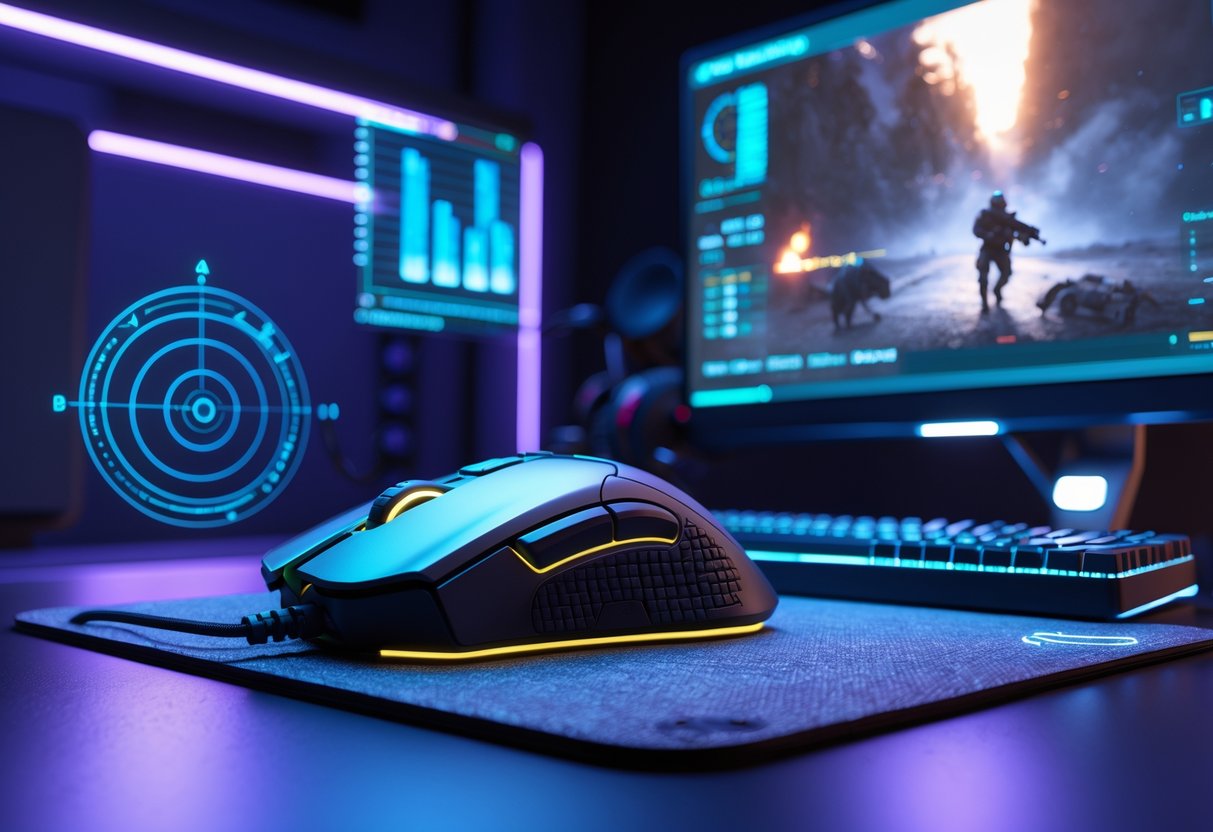
With the right setup, one-handed gaming can be surprisingly fast and precise. The big thing is picking hardware that fits your style and tweaking it to suit your needs.
Improving Gaming Speed and Precision
We’ve noticed tactile feedback really matters in one-handed gaming. Mechanical switches give you that crisp, satisfying response for rapid key presses.
The Razer Tartarus Pro, for example, uses analog optical switches. You get variable input—light presses for walking, firm presses for running. It’s pretty cool, honestly.
Features that make a difference:
- Anti-ghosting stops missed inputs
- Custom key layouts cut down on finger travel
- Programmable macros let you pull off big combos fast
Keep your keypad close to your mouse. Less arm movement means less fatigue. A wrist rest helps your hand stay put and comfortable.
Most people notice improvement after a couple of weeks. The compact layout means less stretching, so you can game longer without your hand getting tired.
Optimising for Fast-Paced Games
Fast shooters and MOBAs demand lightning-fast reactions. We suggest keypads with 25-35 keys for these types of games.
Key placements that help:
- Movement keys (like WASD) under your strongest fingers
- Weapon switches within easy thumb reach
- Communication keys mapped to your pinky
Typing accuracy is important for in-game chat too. Put the most-used letters where your fingers naturally fall. Some players even map whole phrases to a single key.
The RedThunder keypad is a solid pick for competitive play. Its 35 keys hit the sweet spot—not too many, not too few. RGB lighting helps you find keys in the dark.
Practice in training modes before you jump into ranked games. Your reaction time might dip at first, but most players get back to their old level in three or four weeks.
Enhancing Comfort and Reducing Fatigue
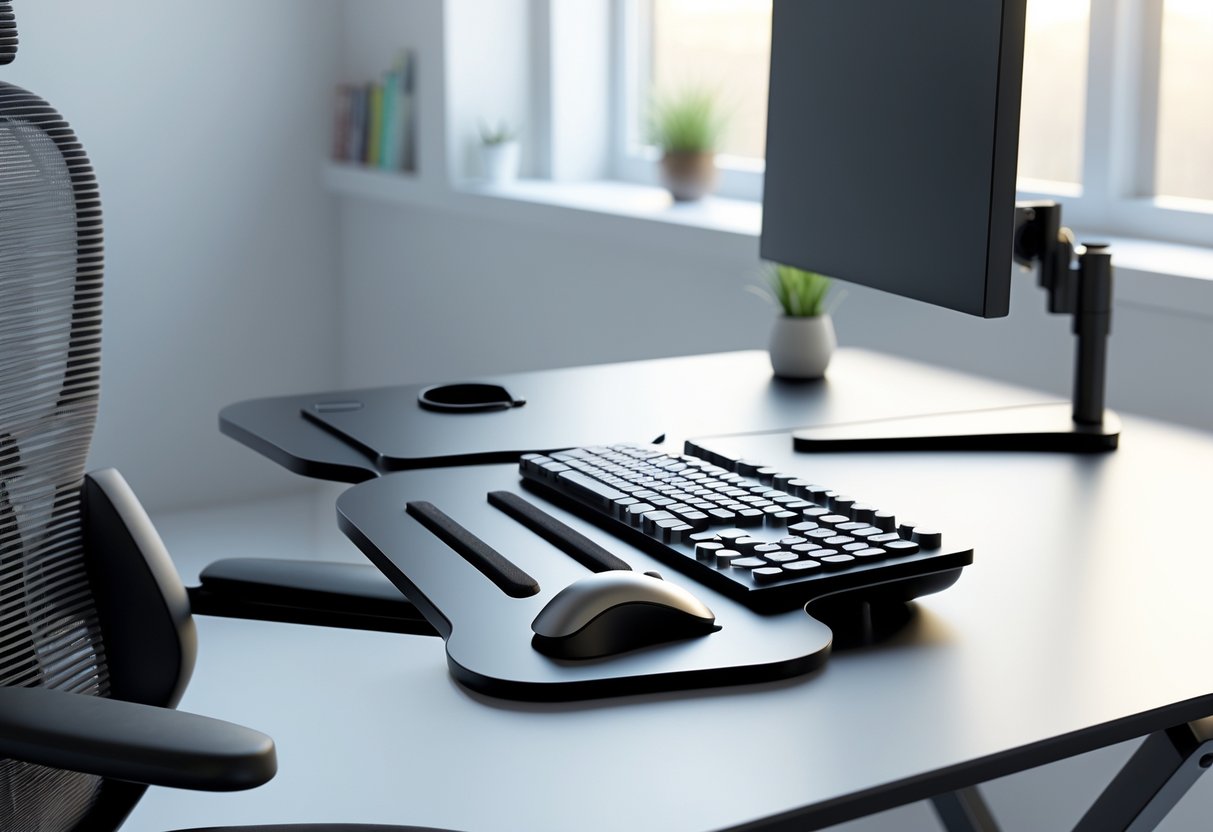
Wrist support and smart positioning can save you from pain during marathon gaming sessions. Good habits keep your hand happy, even when the competition heats up.
Wrist Rests and Hand Positioning
A decent wrist rest can totally change your one-handed gaming life. We like memory foam or gel—the kind that molds to your wrist’s shape.
Set the rest so your hand floats above it while you play. Your wrist should only touch down when you pause.
Some positioning tips:
- Keep your wrist straight—don’t bend up or down
- Let your forearm rest on the desk or chair arm
- Mouse pad should sit at elbow height
- Hold your mouse loosely, not in a death grip
Ergonomic mice make a difference, too. Pick one that fits your hand—too small and you’ll cramp up, too big and you’ll overreach.
Pro gamers often raise their chair so their elbow bends at 90 degrees. That keeps shoulder pain at bay during long stretches.
Reducing Strain During Extended Use
Regular breaks work better than any fancy gear. Take 30 seconds every 15-20 minutes to stretch your hand and rotate your wrist.
Try these simple stretches:
- Bend your wrist up and down gently
- Make a loose fist, then open your hand
- Rotate your wrist in little circles
- Stretch your fingers wide, then relax
Don’t forget about temperature. Cold hands get stiff and tired fast. Keep the room warm or wear fingerless gloves if it’s chilly.
Bump up your mouse sensitivity. That way, you move your wrist less and save energy over long sessions.
If you can, swap mouse hands during casual play. It gives your main hand a break and keeps your brain sharp.
Seriously, stop if you feel sharp pain or numbness. Ignoring pain can lead to injuries that take you out of the game for weeks.
Assistive Technology Solutions
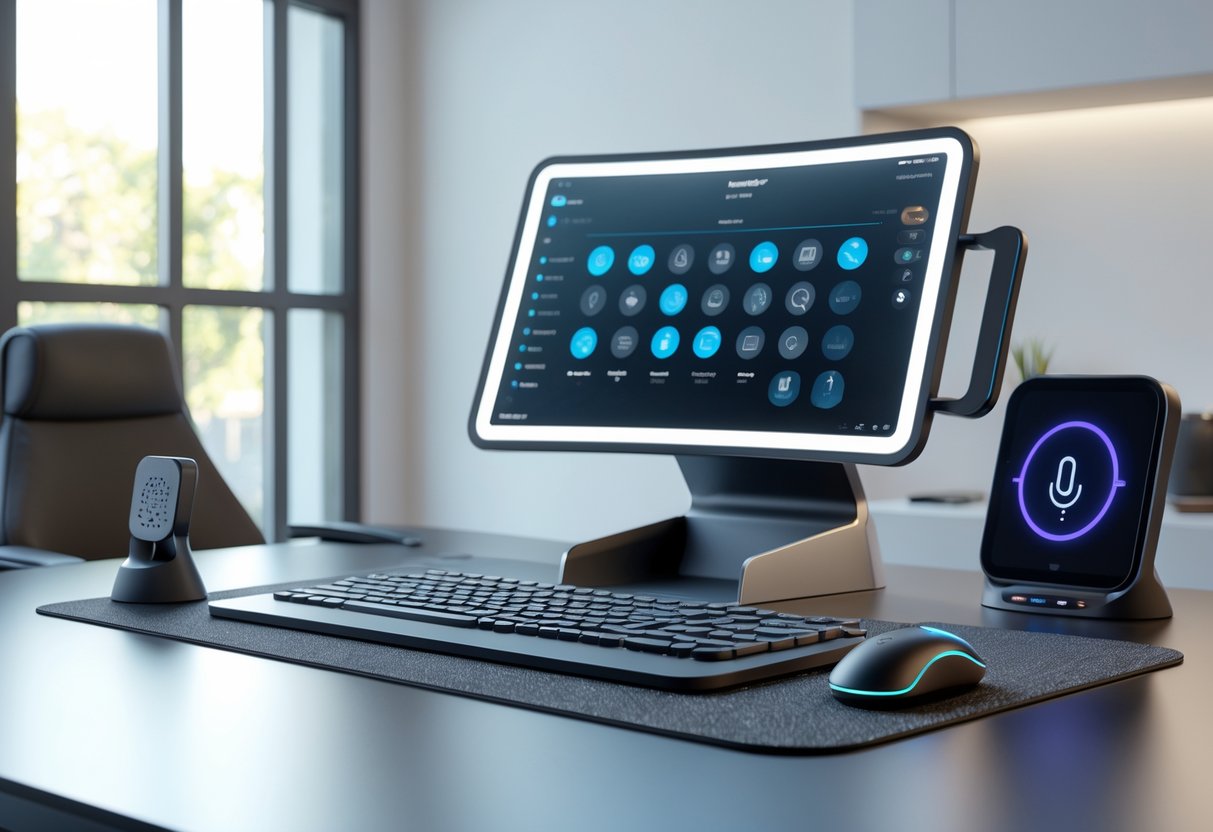
Modern assistive tech has changed the game for players with one functional hand. Hardware mods and clever software make it possible to compete at a high level, even if you need alternative controls.
Adaptive Hubs and Switches
Adaptive hubs let you plug in all sorts of switches and buttons to build your own gaming setup. The Microsoft Adaptive Controller stands out, with big programmable buttons and ports for extra switches.
You can hook up sip-and-puff switches, big button arrays, or even foot pedals. Each input connects to a game function through custom profiles.
Why adaptive hubs are great:
- Lots of 3.5mm jack inputs
- USB ports for switches
- Stores profiles for different games
- Wireless options for less clutter
Logitech’s Adaptive Gaming Kit adds triggers, buttons, and joysticks that work with these hubs.
To set it up, you map each switch to a controller button using the software. Most systems let you save different profiles and switch between them fast.
Standalone One-Handed Controllers
Some controllers are built for one hand right from the start. They pack all the buttons you need into a small area your thumb and fingers can reach.
The Razer Tartarus Pro is a good example. It’s got 32 programmable keys, an eight-way directional pad, and an analog stick—all within easy reach.
What sets these apart:
- Ergonomic design fits your hand
- Lots of macro options
- Adjustable key sensitivity
- RGB lighting to find buttons quickly
Keypads like the Corsair K63 Wireless Lapboard give you one-handed control and wireless freedom. They’re especially handy for strategy games and MMOs with tons of keybinds.
Console gamers have options, too. The Hori Fighting Commander is great for fighting games, putting all the face buttons near your thumb.
Prices range a lot. Basic models start at around £40, but top-end controllers with pro features can hit £150-200.
Software Accessibility Features
Software can change how games read your inputs, no extra hardware needed. These programs run in the background and turn single-hand actions into complex commands.
Voice recognition tools like Dragon NaturallySpeaking let you control games by speaking. You can map voice commands to in-game actions for hands-free play.
Common software perks:
- Remap buttons however you want
- Record and use macros
- Sticky keys for pressing combos one at a time
- Custom key combos
Windows 10 and 11 come with built-in accessibility. The On-Screen Keyboard lets you click keys, and Sticky Keys means you don’t have to hold down combos.
Some gaming software goes further. X-Mouse Button Control remaps mouse buttons to keyboard keys. AutoHotkey lets you build macros that do a bunch of things at once.
Many new games offer their own accessibility settings. You’ll find options for remapping buttons and lowering input complexity.
Setting Up Your Workspace
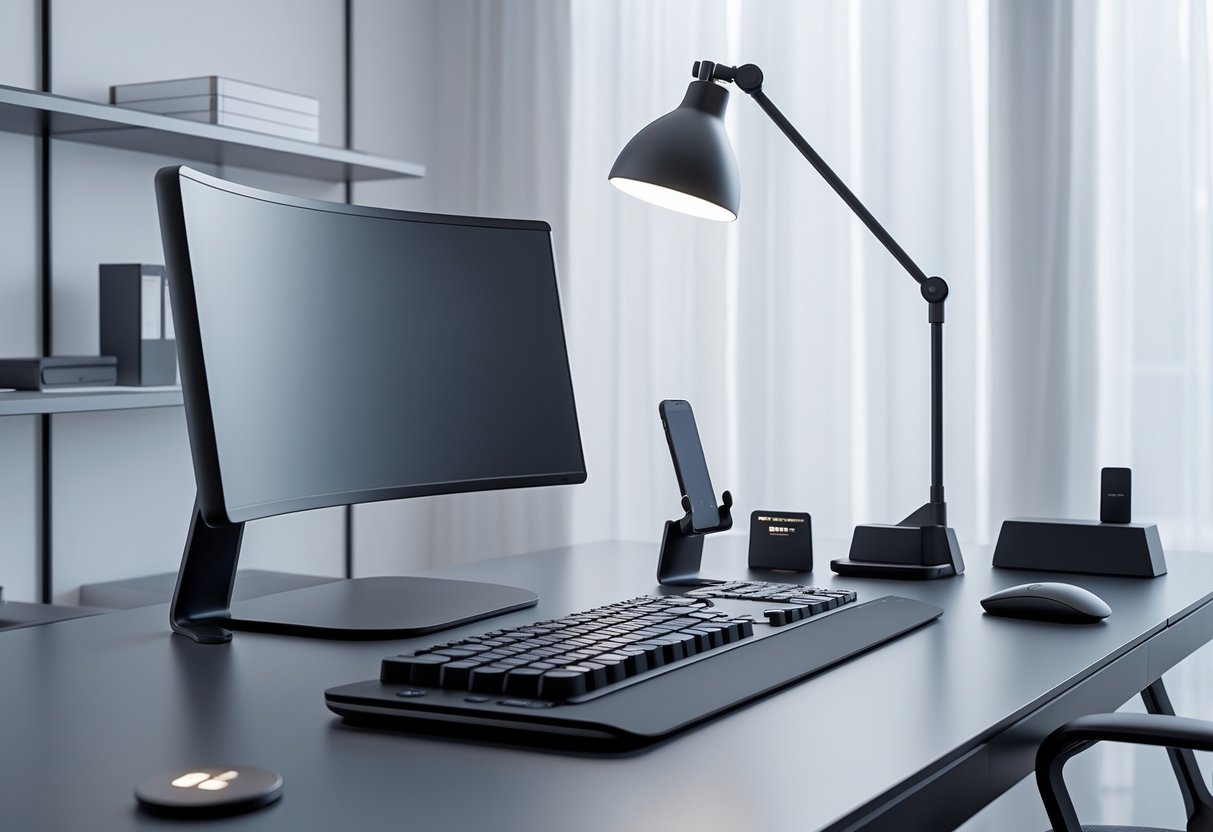
Building a one-handed gaming workspace takes some planning and a bit of creativity. The trick is to keep everything within easy reach and set up your gear so you stay comfortable and avoid strain—especially during those long gaming marathons.
Organising for Accessibility
Keep your most-used items close at hand. Place your mouse, keyboard shortcuts, and essential gaming peripherals within 30cm of your dominant hand. This way, you won’t have to stretch and tire yourself out.
Set up clear zones on your desk. Put your gaming gear (mouse, keypad) on one side and stash your drink, phone, or snacks on the other. This small change really helps you stay focused when you’re deep in a competitive match.
Take advantage of vertical space. Wall-mounted shelves or monitor arms open up your desk and make everything feel less cramped. A clutter-free surface really makes a one-handed setup feel more manageable.
Try using a lazy Susan or a rotating tray for items you swap out often, like different gaming mice or attachments. You’ll grab what you need without awkwardly reaching across your whole desk.
Label your stuff clearly. When you’re in the middle of a game, the last thing you want is to dig around for the right cable. Slap some small adhesive labels on drawers and containers to save yourself precious seconds.
Tips for Effective Desk Layout
Set your monitor at eye level. Place your screen about 50-70cm away, with the top edge at or just below your eyes. This helps prevent neck strain during those hours-long sessions.
Leave about 15-20cm between the edge of your desk and your keyboard. This gives your wrist room to rest naturally while you’re gaming. Lots of one-handed players swear by a wrist rest for longer play.
Tidy up your cables with clips or trays. Nothing kills your momentum like yanking a cable mid-game. Route wires behind your monitor or under the desk with some simple cable management tricks.
| Item | Ideal Distance | Height |
|---|---|---|
| Monitor | 50-70cm | Eye level |
| Mouse pad | 15cm from edge | Elbow height |
| Secondary screen | Arm’s length | Slightly angled |
Get your lighting right. Avoid glare on your screen, but make sure you can see your peripherals. A small desk lamp behind your monitor usually does the trick.
Keep backup gear handy in a drawer. Extra mice, cables, or accessories should be easy to grab. When something fails, you can swap it out and get back to gaming fast.
Learning Curve and Adjustment Strategies

Switching to a one-handed gaming setup takes patience and regular practice. You’ll need to rebuild muscle memory and push through some early frustration. Most players settle in after about 2-4 weeks.
Building Confidence Through Practice
Start with familiar games to make the shift to one-handed gaming less jarring. Slower-paced titles, like strategy games or RPGs, work best at first.
Keep practice sessions short— aim for 15-30 minutes at the start. If you go longer, you’ll probably just get tired and pick up bad habits.
Try a daily routine like this:
- 10 minutes of one-handed typing software
- 15 minutes of simple gaming (menus, basic movement)
- 5-minute breaks to shake off any strain
Quick win: Play typing games made for one-handed typists. They’ll help your fingers get used to working together before you jump into actual games.
Most people see progress like this:
- Week 1: Basic navigation gets easier
- Week 2: Simple mechanics start to feel natural
- Week 3-4: You’ll handle complex actions without thinking
Time yourself on certain tasks and watch your speed improve. It’s a real confidence booster.
Overcoming Common Challenges
Muscle memory confusion hits almost everyone at first. Your brain expects the keys to be under certain fingers, so you’ll hesitate and make mistakes.
Fight this by:
- Practising one key combo over and over (20-30 times)
- Using colored key caps for important buttons
- Starting every session with the same warm-up
Fatigue creeps in if you overwork your dominant hand. Take a five-minute break every 20 minutes.
Heads up: If you’re feeling pain, stop. Pushing through it can lead to repetitive strain injuries that’ll set you back.
Performance anxiety can mess with your head, especially in competitive games. Try these:
- Play against AI for a while
- Join beginner-friendly groups
- Focus on getting better, not just winning
Quick win: Record your gameplay. You’ll spot exactly where you pause or fumble, so you can work on those moves in practice.
A lot of players eventually find they match or even beat their old two-handed skills, especially in games where timing matters more than juggling tons of buttons.
Maintenance and Troubleshooting
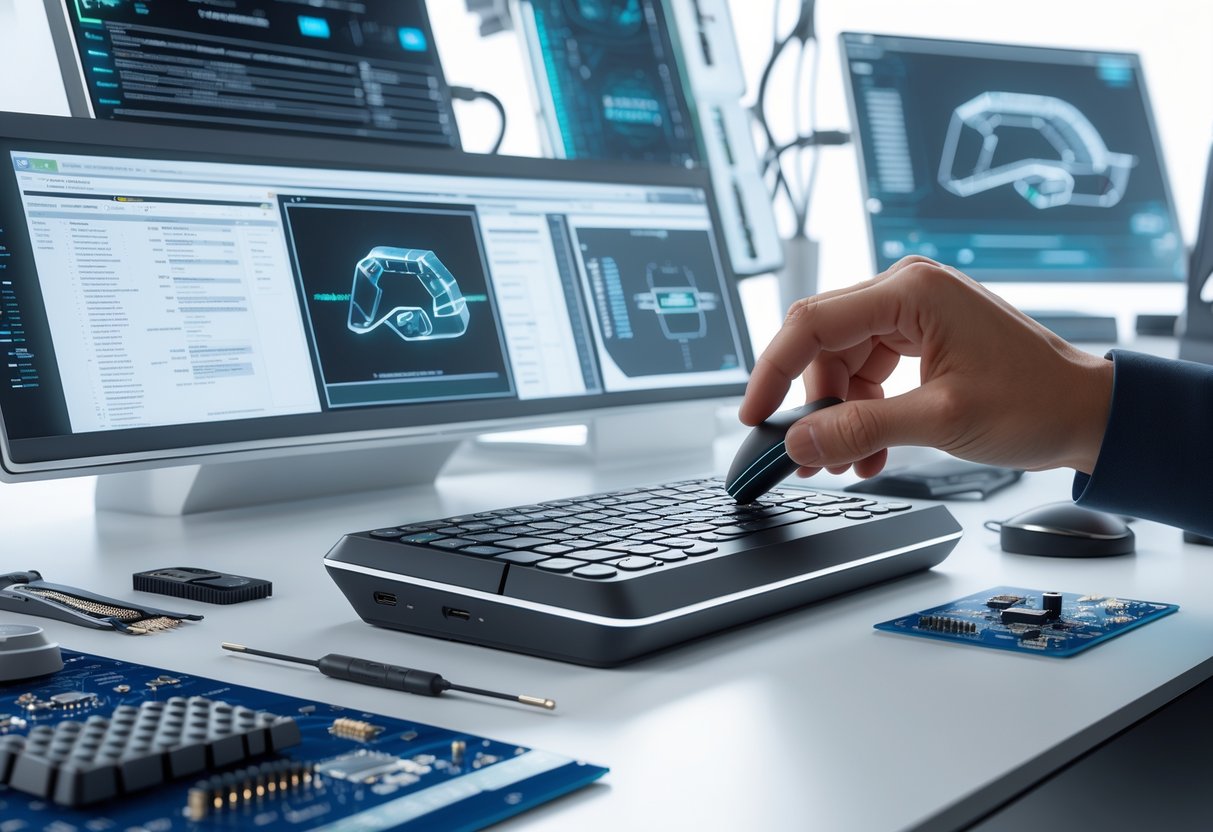
Take care of your one-handed gaming setup and it’ll last for years. Fixing common problems quickly saves you hassle and keeps you in the game.
Cleaning and Care for Devices
One-handed keyboards need regular cleaning to keep them working well. Dust, crumbs, and oils build up fast.
Blast the keyboard with compressed air once a week to clear out debris. This helps prevent sticky or unresponsive keys.
Wipe surfaces with a damp cloth and a little mild cleaner. Don’t spray liquid right onto the keyboard.
For a deeper clean, pop off the keycaps with a puller and soak them in soapy water. Clean the base with a cotton swab.
A few maintenance tips:
- Wipe up spills right away to avoid sticky keys
- Use a keyboard cover for long sessions
- Store your gear somewhere dust-free
Swap out worn keycaps before they mess with your gameplay. Most gaming keyboards use standard sizes, so replacements are easy to find.
Solving Common Setup Issues
Unresponsive keys pop up a lot with one-handed keyboards. First, make sure the device is plugged in properly—USB or wireless.
Try another USB port if you’re wired. For wireless, check the batteries or re-pair the device.
Update your keyboard drivers through Device Manager on Windows if you notice input lag or missed keystrokes.
If you’re having gaming software trouble:
- Reset key mappings to default
- Close any background programs that could cause conflicts
- Restart your computer to clear things out
Quick troubleshooting steps:
- Test the keyboard on another computer
- Look for driver updates
- Double-check game key bindings
- Restart your gaming software
If nothing works, reach out to the manufacturer’s support. Most brands have solid technical help for these issues.
Emerging Innovations in One-Handed Setups

New assistive tech is making one-handed gaming more accessible than ever. Companies keep rolling out keyboards with tilt controls and AI-powered systems that adjust to your needs.
Latest Developments in Keyboard Tech
One-handed gaming keyboards have come a long way. Modern ones use tilt-based inputs, so you can type or control games with subtle hand movements. This is especially handy if you can’t see your keyboard while playing VR games.
The newest keyboards mix traditional keys with thumbsticks and programmable buttons. Some models put every important control right under your left hand. You won’t need to stretch across a full keyboard anymore.
Cool features in new models:
- Custom key mapping
- Built-in joysticks
- Macro buttons for tricky combos
- Ergonomic wrist rests
Some companies add software that learns your habits. It’ll suggest better key layouts for your favorite games.
Future Trends in Accessibility
Gaming accessibility is moving toward full ecosystems, not just single gadgets. The UniGrip Controller is a good example—it bundles hardware, software, and a support community.
AI assistants are quickly becoming the norm. They can tweak button sensitivity on the fly during long sessions and even give real-time tips based on your gameplay.
What’s next:
- Voice commands paired with hand controls
- Gesture recognition in VR
- Smart controllers that adjust as you get tired
- Community hubs for sharing custom setups
Gaming brands and rehab centers are teaming up now. This helps developers make gear that feels less like medical equipment and more like something you’d actually want to use for gaming.
Frequently Asked Questions
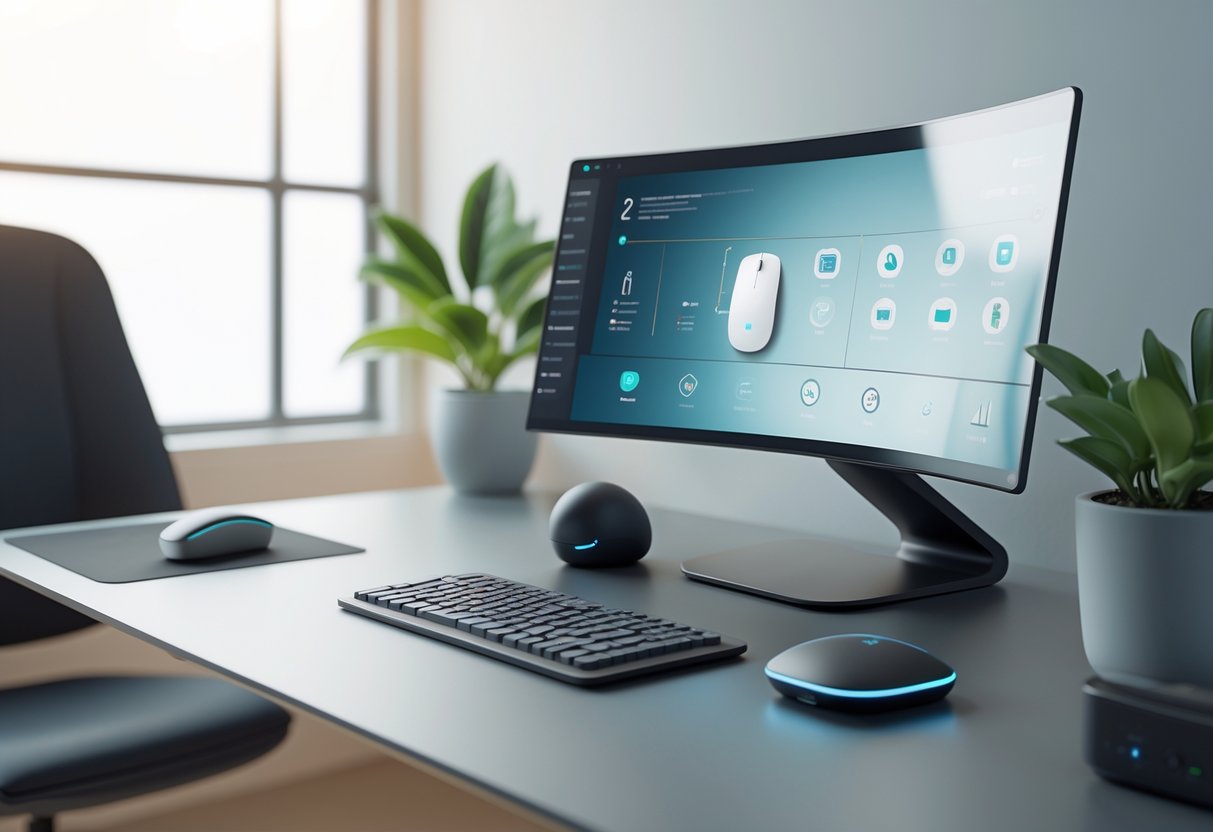
Gamers ask a lot of the same questions about controllers, customization, and which games work best with one hand. Here are some of the most common answers.
What are some popular video games that can be played using only one hand?
Turn-based strategy games are perfect for one-handed play. Civilization VI, XCOM 2, and Crusader Kings III let you think through each move at your own pace.
Card games are a great fit too. Hearthstone, Slay the Spire, and Gwent: The Witcher Card Game all use simple mouse clicks.
Lots of indie puzzle games work well. Try Papers Please, Return of the Obra Dinn, or Baba Is You—they’re all about thinking, not fast reflexes.
Some RPGs, like Divinity: Original Sin 2 and Disco Elysium, also offer pause-and-plan gameplay that doesn’t demand quick reactions.
Are there any specially designed controllers available for one-handed play on classic systems like the SNES or N64?
The Xbox Adaptive Controller works with many retro setups if you use the right adapters. You can hook it up to old hardware with third-party converters.
Some companies make one-handed controllers just for retro systems. The Hori Mini Pad, for example, gives classic Nintendo systems a simpler control scheme.
Custom shops like Ben Heck build modified original controllers. They’re pricey—usually £200-400—but you get the authentic feel with one-handed use.
Emulation is often the easiest route. You can remap controls for old games to work with modern one-handed controllers through emulator software.
How can I customise existing game controllers to suit one-handed gameplay?
Button remapping software is the simplest way to start. Steam’s controller tool lets you reassign buttons or set up macros.
Physical mods take more work but can be worth it. Move buttons, add extensions, or build custom grips using things like sugru or 3D prints.
Foot pedals can really expand your options. The Stinky Footboard or basic USB pedals handle things like jumping or reloading.
If you want something more advanced, professional mod services exist. AbleGamers, for instance, offers free consultations and can point you to local techs for custom jobs.
Could you suggest any one-handed control solutions for the Nintendo Switch?
The HORI Split Pad Compact is great for one-handed use in handheld mode. It’s smaller than Joy-Cons and easier to grip.
Third-party controllers like the 8BitDo SN30 Pro let you do button remapping with their software. You can set up profiles for one-handed play.
The Nintendo Switch Pro Controller lets you move functions to reachable buttons through system settings.
If handheld mode is tricky, try tabletop mode with a wireless controller placed for easy one-handed access.
Where might I find 3D printing designs for an Xbox controller modified for one-handed use?
Thingiverse has loads of Xbox controller mod files. Search for “one handed controller” or “adaptive gaming” for the best results.
The Enable Community Foundation shares tested 3D printing files for gaming gear. Their designs are checked to make sure they work.
MyMiniFactory lists both free and paid controller mods, often with step-by-step instructions.
GitHub is another good place—many open-source controller projects include 3D files and even code for electronic tweaks.
Which Steam games are recommended for players looking for a one-handed gaming experience?
Steam actually makes it a bit easier to find these games. You can filter by “Mouse Only” or “Relaxing” tags to spot titles that don’t need a ton of buttons or complicated input.
Management games are honestly some of the best for one-handed play. You might want to try Two Point Hospital, Prison Architect, or Cities: Skylines—each one lets you get by with simple point-and-click controls.
Visual novels barely require any input at all. The Phoenix Wright series, VA-11 Hall-A, and Doki Doki Literature Club let you play almost entirely with mouse clicks.
Plenty of simulation games also work really well with one hand. Euro Truck Simulator 2, Planet Coaster, and Kerbal Space Program all let you pause whenever you want, and you can tweak the controls to fit what works for you.

